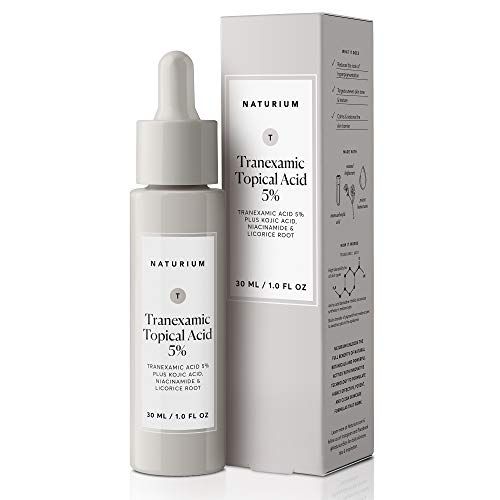For too long, the battle against hyperpigmentation—whether the stubborn, hormonal patches of melasma or the lingering red and brown marks left by acne—has been waged with harsh, irritating ingredients that often compromise the skin barrier. The pursuit of a bright, even complexion seemed inevitably linked to redness and sensitivity. But a new, scientifically validated player has emerged from the world of clinical medicine: Tranexamic Acid. Once a prescription-only compound used to control bleeding, this synthetic derivative of the amino acid lysine has been repurposed for topical skincare, quickly becoming the gold standard for tackling discoloration without the drama. It represents a paradigm shift, offering a profound ability to interrupt the melanin-producing pathway and calm inflammation, paving the way for a beautifully balanced and visibly clearer skin tone—all within the accessible format of a daily serum.
The Breakthrough Ingredient Borrowed from Medicine
Tranexamic Acid (TXA) is a classic example of an accidental yet profound discovery in dermatology. Its origins lie far outside the beauty aisle, where it was historically used as an antifibrinolytic agent to manage blood loss during surgery and trauma. It was through this medical application that physicians inadvertently began to observe a remarkable side effect in their patients: a visible improvement in pre-existing skin discoloration. This observation launched years of research that ultimately cemented its role as a star topical skincare ingredient.

The mechanism by which TXA works is unique and elegant, distinguishing it from aggressive exfoliating acids. Instead of merely stripping away pigmented cells, TXA functions by inhibiting the activity of an enzyme called plasmin within the skin’s keratinocytes. This plasmin-blocking action serves a dual purpose: it directly interrupts the pathway that triggers melanogenesis (the production of melanin pigment), effectively preventing the formation of new dark spots. Simultaneously, it exerts powerful anti-inflammatory effects by reducing the mediators that would otherwise stimulate melanocyte activity, thus addressing the often-overlooked inflammatory component of conditions like melasma and post-acne marks. This targeted, two-pronged strategy allows TXA to address discoloration at its root cause without creating the irritation and sensitization that lead to further pigmentation.
Decoding the Gentle Power Against Hyperpigmentation
The core strength of a Tranexamic Acid serum lies in its comprehensive efficacy against the most frustrating forms of skin discoloration. Its ability to suppress melanin production makes it exceptionally beneficial for fading deep-seated melasma, which is notoriously difficult to treat as it is triggered by a combination of hormones, sun exposure, and inflammation. Unlike older, more aggressive treatments which cannot be used long-term, TXA offers a sustainable, daily option to keep these stubborn brown and gray patches at bay.

Furthermore, TXA is highly effective against Post-Inflammatory Hyperpigmentation (PIH), the red and brown marks left behind after acne breakouts or other skin injuries. By calming the underlying inflammation—which is the initial trigger for PIH—and then inhibiting the pigment production, the serum speeds up the fading process, leading to a much faster return to a uniform complexion. Because it operates without harsh exfoliation, Tranexamic Acid is generally safe and well-tolerated by all skin types, including those who are typically prone to sensitivity or redness, and it can be used year-round without requiring the temporary breaks associated with other depigmenting actives. This characteristic of efficacy without irritation makes it a game-changer for those previously unable to tolerate strong brightening treatments.
The Synergy Advantage: Power Pairing for Maximum Effect
While Tranexamic Acid is a powerful standalone ingredient, its true potential is realized when combined with synergistic co-actives. Skincare experts and formulators rarely recommend TXA as a solitary treatment, preferring to utilize its unique inhibitory function as the anchor in a multi-action approach to pigmentation. When formulated together, these combinations address the problem from every angle: preventing production, breaking down existing pigment, and protecting against future damage.

The most potent pairing is TXA with Niacinamide (Vitamin B3), which works to halt the transfer of melanin pigment from the melanocyte to the skin’s surface cells, while simultaneously strengthening the skin barrier and regulating oil production. Another highly effective combination is with Vitamin C or Kojic Acid, both powerful antioxidants that directly brighten and protect against environmental stressors that cause pigmentation in the first place. For individuals targeting fine lines alongside discoloration, TXA is one of the few acids that layers beautifully with Retinol and other Retinoids. In fact, TXA can maximize the spot-fading benefits of Vitamin A derivatives, making the two an exceptionally robust combination for comprehensive skin renewal and anti-aging.
Navigating the New Serum Landscape
With Tranexamic Acid now ubiquitous in the beauty market, navigating the array of serums can be challenging. Consumers should look for serums that disclose the percentage, typically ranging from 2% to 5%, to ensure clinical efficacy. The choice of formula often depends on a user’s primary concern and routine complexity. For beginners or those with mild, new hyperpigmentation, a budget-friendly option combined with supporting ingredients like Acai Berry or gentle hydrators is an excellent entry point.

For those tackling chronic conditions like melasma or deep-seated PIH, a more clinical-grade serum featuring a multi-active complex is advisable. These formulations usually contain TXA alongside multiple complementary brighteners, such as Kojic Acid and high concentrations of Niacinamide, in a sophisticated delivery system. Regardless of the serum chosen, the application is simple: it should be applied to clean skin before any heavy moisturizers, up to twice a day. As with all pigmentation treatments, the final and most crucial step for maintaining long-term results is the unwavering daily use of a broad-spectrum, high-SPF sunscreen, which is the only reliable defense against the UV exposure that triggers new discoloration. With consistent use, visible improvements in tone and clarity can often be observed within four to six weeks, cementing TXA’s place as a fundamental requirement for truly luminous skin.




